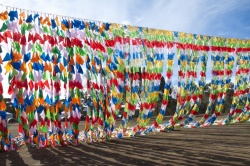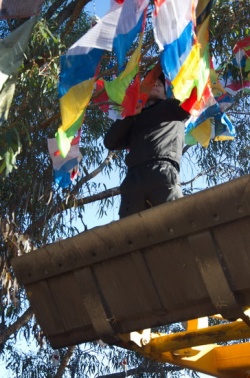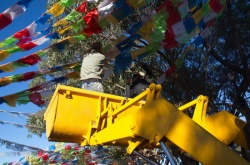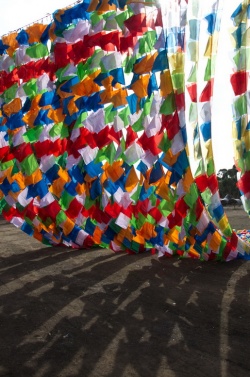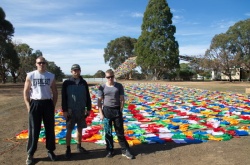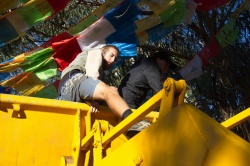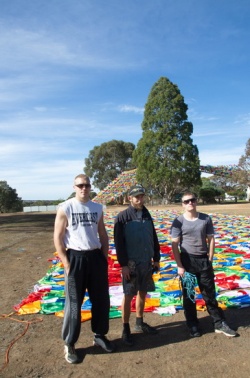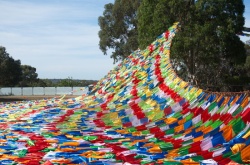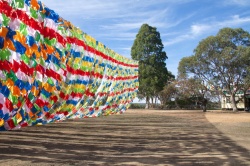The Prayer Flag Tradition
To me there are few things more beautiful than colorful prayer flags fluttering in
the wind- sometimes waving gently, sometimes raging; a dance of shadow and
Light. There is perhaps no simpler way to create good Merit in this troubled World
of ours than to put prayer flags up for the benefit of other living beings. Prayer
flags are not just pretty pieces of colored cloth with funny Writing on them. The
ancient Buddhist prayers, mantras and powerful symbols displayed on them
produce a spiritual vibration that is activated and carried by the wind across the
countryside. All beings that are touched by the wind are uplifted and a little happier. The silent prayers are Blessings spoken on the Breath of nature. Just as a drop of water can permeate the ocean, prayers dissolved in the wind extend to fill all of space.
The Prayer Flag tradition has a long continuous history dating back to ancient
Tibet, China, Persia and India. The tradition has now reached the West and is
rapidly gaining popularity. The meanings behind Prayer Flag texts and symbols,
indeed behind the whole idea of prayer flags, are based on the most profound
concepts of Tibetan Buddhist Philosophy.
The Tibetan word for Prayer Flag is Dar Cho. “Dar” means to increase Life,
Fortune, health and Wealth. “Cho” means all Sentient beings. Prayer flags are
simple devices that, coupled with the natural energy of the wind, quietly
harmonize the environment, impartially increasing Happiness and good Fortune
among all living beings.
History
According to some lamas prayer flags date back thousands of years to the Bon tradition of preBuddhist Tibet. Shamanistic Bonpo priests used primary colored
plain cloth flags in Healing ceremonies. Each color corresponded to a different
primary element - earth, water, Fire, air and space – the fundamental building
blocks of both our physical bodies and of our environment. According to Eastern
medicine health and Harmony are produced through the Balance of the 5
elements. Properly arranging colored flags around a sick patient harmonized the
elements in his Body helping to produce a state of physical and Mental health.
Colored flags were also used to help appease the local gods and spirits of the
mountains, valleys, lakes and streams. These elemental beings, when provoked
were Thought to cause natural disasters and disease. Balancing the outer
elements and propitiating the elemental spirits with rituals and offerings was the
Bonpo way of pacifying nature and invoking the Blessings of the gods.
It is not known whether or not the Bonpos ever wrote words on their flags. The
preBuddhist religions of Tibet were oral traditions; Writing was apparently limited
to government bookkeeping. On the other hand the very word, “bonpo,” means
“one who recites magical formulas” Even if no Writing was added to the plain
strips of cloth it is likely that the Bonpos painted sacred symbols on them. Some
symbols seen on Buddhist prayer flags today undoubtedly have Bonpo origins,
their meaning now enhanced with the deep significance of Vajrayana Buddhist
philosophy.
From the first millennium AD Buddhism gradually assimilated into the Tibetan
way of Life reaching great Zeal in the ninth century when the religious King of
Tibet invited the powerful Indian Meditation master, Guru Padmasambhava, to
come and control the forces then impeding the spread of Buddhism. Guru
Rinpoche, as he is popularly known, bound the local Tibetan spirits by oath and
transformed them into forces compatible with the spread of Buddhism. Some to
the prayers seen on flags today were composed by Guru Rinpoche to pacify the
spirits that cause disease and natural disasters.
Originally the Writing and images on prayer flags were painted by hand, one at a
time. Woodblocks, carefully carved in mirror image relief, were introduced from
China in the 15th century. This invention made it possible to reproduce identical
prints of the same design. Traditional designs could then be easily passed down
from generation to generation.
Famous Buddhist masters created most Prayer Flag designs. Lay craftsmen make copies of the designs but would never think of actually creating a new design. There are relatively few basic designs for a continuous tradition that goes
back over a thousand years. Aside from new designs no real innovations to the
printing process have occurred in the past 500 years. Most prayer flags imported
to the West today are woodblock printed. Some shops are now starting to
produce prints made from zinc faced blocks that can be etched photographically
resulting in finer detail than the hand carved woodblock. Natural stone ground
pigments have been replaced by printing inks, usually having a kerosene base.
Most of the companies in the west prefer to use silkscreen printing techniques as wood carving is a time consuming skill requiring lengthy apprenticeship. When the Chinese took over Tibet they destroyed much of everything having to
do with Tibetan culture and Religion. Prayer flags were discouraged but not
entirely eliminated. We will never know how many traditional designs have
been lost forever since the turmoil of China’s cultural revolution. Because cloth
and paper prints deteriorate so quickly the best way to preserve the ancient
designs is by saving the woodblocks. Woodblocks, often weighing several
pounds, were too heavy for the refugees to lug over the Himalayas and
woodblocks no Doubt made wonderful firewood for Chinese troops. Most of the
traditional prayer flags today are made in Nepal and India by Tibetan refugees or
by Nepali Buddhists from the Tibetan border regions.
Texts
Early in the 7th Century the Tibetan King Song Tsen Gompo sent his minister to India to learn Sanskrit and Writing. The Tibetan script we see today on prayer flags was modeled after an Indian script used at that time. Texts seen on prayer
flags can be broadly categorized as Mantra, Sutra and prayers.
A Mantra is a Power-laden syllable or series of syllables or sounds with the
capacity of influencing certain energy dimensions. The vibration of Mantra can
control the invisible energies and occult forces that govern existence. Continuous
repetition of mantras is practiced as a Form of Meditation in many Buddhist
schools. Mantras are almost always in Sanskrit – the ancient Language of
Hinduism and Buddhism. They range in length from a single “seed syllable” like
OM to long mantras such as the “Hundred-syllable Mantra of Vajrasattva.” They
are not really translatable; their inner meanings are beyond words.
Probably the oldest Buddhist Mantra and still the most widespread among
Tibetans is the six-syllable Mantra of Avalokiteshvara, the Bodhisattva of
Compassion. OM MANI PADME HUNG! Printed on prayer flags the Mantra
sends Blessings of Compassion to the six worldly realms.
Sutras are prose texts based on the discourses directly derived from
Shakyamuni Buddha, the historical Buddha who taught in India 2500 years ago.
Many sutras have long, medium and short versions. Prayer flags use the medium
or short versions. One short Form of Sutra often seen on Prayer Flag is the
Dharani. Closely related to mantras, dharanis contain magical formulas
comprised of syllables with symbolic content. They can convey the essence of a
teaching or a particular state of Mind. The Victory Banner (Gyaltsen Semo)
contains many lines of Dharani. Praise to the 21 Taras, the Long Life Flag and
the White Umbrella are also examples of prayer flags using Sutras.
For purposes of categorization all the other text seen on prayer flags can fall
under the general term “prayers.” These would include supplications, aspirations
and good wishes written by various masters throughout the history of Mahayana
Buddhism.
Symbols
In an article this size it is impossible to adequately explain the meanings of all the symbols used on Tibetan prayer flags. Symbols by definition have meanings larger than their mere appearance. In the case of sacred Buddhist symbols the meanings are often hinting at vast notions beyond words. Long treatises have been written on the meanings of such symbols. Listed below are brief meaning of some of the more common symbols.
The Wind Horse
The Wind Horse (Lung-ta) carrying the “Wish Fulfilling Jewel of Enlightenment” is the most prevalent Symbol used on prayer flags. It represents good Fortune; the uplifting Life force energies and opportunities that makes things go well. When one’s lung-ta is low obstacles constantly arise. When lung-ta is high good opportunities abound. Raising Wind Horse prayer flags is one of the best ways
The Eight auspicious symbols
The Eight auspicious symbols (Tashi Targye) is one of the most popular Symbol groupings among Tibetans and also one of the oldest, being mentioned in the Pali and Sanskrit canonical texts of Indian Buddhism.
These Eight Symbols of Good Fortune are:
- The Parasol- which protects from all Evil
- The Golden Fish – representing Happiness and beings saved from the sea of Suffering
- The Treasure Vase – sign of fulfillment of spiritual and material wishes
- The Lotus- Symbol of purity and spiritual unfoldment
- The Conch Shell – proclaims the teachings of the Enlightened ones
- The Endless knot- symbolizing Meditative Mind and infinite Knowledge of The Buddha
- TheVictory Banner – symbolizes the victory of Wisdom over Ignorance and the overcoming of obstacles
- the Dharma Wheel – Symbol of spiritual and universal law to raise one’s lung-ta energy.
The Vajra
The Vajra (Tibetan: Dorje) is the Symbol of indestructibility. In Buddhism it represents true reality, the being or essence of everything existing. This pure Emptiness is unborn, imperishable and unceasing.
The Four Dignities
The Four Dignities - These four Animals: the Garuda, the Sky Dragon, the Snow Lion and the Tiger are seen in the corners of many Tibetan prayer flags – often
accompanying the Wind Horse. They represent the qualities and attitudes
necessarily developed on the spiritual path to Enlightenment. These are qualities
such as awareness, vast vision, confidence, Joy, humility and Power.
The Seven Precious Possessions of a Monarch
The Seven Precious Possessions of a Monarch –
- Precious Wheel
- Precious Jewel
- Precious Queen
- Precious Minister
- Precious Elephant
- Precious Horse
- Precious General
These seven objects collectively symbolize secular Power. They give the ruler
Knowledge, resources and Power. In the Buddhist interpretation a comparison is
drawn between the outward rule of the secular king and the spiritual Power of a
practitioner. To the spiritual practitioner the Seven Jewels represent boundless
Wisdom, inexhaustible spiritual resources and invincible Power over all inner and
outer obstacles.
The Union of Opposites
The Union of Opposites (mithun gyulgyal) is an interesting group of symbols. These mythological beings are joined rival pairs of Animals created to symbolize Harmony. A Snow Lion and a garuda, normally mortal enemies, were combined to
Form an animial with a Snow Lion’s Body and a garuda’s head and wings.
Likewise a fish was put together with an otter and a crocodile-like chu-srin was
married to a Conch shell. These composed creatures are often put on Victory Banners for the reconciliation of disharmony and disagreement.
Deities and Enlightened Beings
Deities in Vajrayana Buddhism are not gods as such but representations of the aspects of Enlightened Mind. Their postures, hand gestures, implements and ornaments symbolize various qualities of the
particular aspect. The three main aspects of Enlightened Mind are Compassion,
Wisdom and Power, represented respectively by Avalokiteshvara, Manjushri and
Vajrapani. There are other images depicted on prayer flags that look very similar
to the transcendental deities. These are actually Enlightened human beings such
as Shakyamuni Buddha, Guru Padmasambhava, and Milarepa.
The Elements
Vajrayana Buddhism divides the phenomenal and psycho-cosmic World into five basic energies. In our physical World these manifest as earth, water, Fire, air and space. Our own bodies and everything else in the physical World is composed of these five basic elements. On a spiritual level these basic energies correspond
to the 5 Buddha Families and the 5 Wisdoms. Prayer flags reflect this
comprehensive system through color; each of the 5 colors relates to an element
and an aspect of Enlightened Mind. It should be noted that there are two
systems used so there is sometimes confusion about which color corresponds to
which element. The order of the colors in Prayer Flag displays remains the same
in both the systems. The color order is always: yellow, green, red, white and
blue. In a vertical displays the yellow goes at the bottom and the blue at the top.
For a horizontal display the order can go either from right to left or from left to
right.
According to the Nyingma School (Ancient Ones) the color element correspondence is:
- Blue – space
- White – air (sometimes referred to wind or cloud)
- Red – Fire
- Green – water
- Yellow – earth
The New Translation Schools switch the colors for air and water but keep the
order of the colors the same.
Categories of Prayer Flags
Prayer Flag types can be divided into about two-dozen categories; half a dozen of which comprise a large majority of the flags we see today.
Wind Horse (Lung- ta)
Wind Horse (Lung- ta) flags are by far the most common Prayer Flag, so much so that many people think that the word lung-ta means Prayer Flag. Their purpose is to raise the good Fortune energy of the beings in the vicinity of the Prayer Flag.
The wind horse, usually in pictorial Form, always occupies the center of this flag.
The outside corners of the flag is always guarded by the four great Animals – the
garuda, dragon, tiger and Snow Lion – either in pictorial Form or in written word.
The texts on the flags differ; usually a collection of various mantras or a short
Sutra. The Victory Banner Sutra (Gyaltsen Semo) is the most popular.
Victorious Banners
Victorious Banners are used to overcome obstacles and disturbances. Shakyamuni Buddha gave the Victory Banner Sutra to Indra, king of the God realm. Indra was instructed to repeat this Sutra when going into battle in order to
protect his troops and to assure victory over the demigods. The Sutra has many
protective dharanis to overcome obstacles, enemies, malicious forces, diseases
and disturbances. Victory Banner flags display this Sutra along with symbols
such as the wind horse, the Eight auspicious symbols, the Seven Possessions
of a Monarch and the Union of Opposites. Often there are special mantras
added to increase Harmony, health, Wealth and good Fortune.
Health and Longevity Flags
Health and Longevity Flags usually have a short version of The Buddha’s Long Life Sutra along with prayers and mantras for health and long Life. Amitayus, the Buddha of Limitless Life is often in the center of the flag. Two other long Life Deities, White Tara (peace and health) and Vijaya (victorious protection) are sometimes included.
The Wish Fulfilling Prayer (Sampa Lhundrup)
The Wish Fulfilling Prayer (Sampa Lhundrup) is a powerful protection prayer written by Guru Padmasambhava. It is said to be especially relevant to our modern age and is good for raising one’s Fortune, protecting against War, famine,
and natural disasters, as well as overcoming obstacles and quickly attaining ones
wishes. These flags often have Guru Rinpoche in the center and repetitions of
his powerful Mantra OM Ah HUNG Vajra Guru PADMA Siddhi HUNG.
Praise to the 21 Taras
Praise to the 21 Taras was composed by the primordial Buddha Akshobhya. It was written into Sanskrit and Urdu by Vajrabushan Archarya and translated into Tibetan by Atisha in the 11th century. The first 21 Tara prayer flags are attributed
to him. Tara was born from the compassionate tears of Avalokiteshvara. As he
shed tears for the countless Suffering beings one tear transformed into the
Savioress Green Tara who then manifested her twenty other forms. The prayer
to the 21 Taras praises all her manifestations. The flags with this prayer usually
depict Green Tara in the center and often conclude with her root Mantra OM
TARE TUTARE TURE SOHA. The purpose of this flag is to spread
compassionate Blessings.
Other Prayer Flag categories are too numerous to describe in this article but a few
of the more popular designs are listed as follows: Avalokiteshvara – Bodhisattva
of Compassion, The Warrior-King Gesar, The White Umbrella for protection, the
Kurukulle Power Flag, Manjushri- Embodiment of Wisdom, Milarepa – the Yogisaint,
and the Vast Luck Flag.
Raising Prayer Flags
Prayer flags typically come on ropes to be Hung in horizontal displays or printed on long narrow strips of cloth that are tied on vertical poles. Prayer flags on ropes are printed on 5 different colors of cloth (yellow, green, red, white and blue)
so sets are always in multiples of 5. Pole flags are either a single solid color or
the 5 colors sewn together into one flag. They range in height from about 3ft to
40 ft or more. Pole flags often have colored streamers or “tongues” that are
imprinted with special increasing mantras meant to increase the Power of the
prayers written on the Body of the flag. It is also common to see displays of many
plain white prayer flags on poles erected around Monasteries and pilgrimage
sites.
Most of the imported prayer flags are printed on polyester or nylon blends. Surprisingly, good quality cotton is hard to find in Nepal and India. Wholesale price differences for prayer flags are often due to the different qualities of cloth.
Tibetans don’t Mind the gauzy low thread count cloth (the wind passes through it
easily) but Americans tend to prefer finer quality materials. Synthetics vs. cotton
is a matter of opinion. Some feel that polyester and nylon are more durable,
some say they fade faster. Cotton colors tend to be richer and cotton threads are
better for the environment (I frequently see pieces of prayer flags in birds nests
around my studio). Radiant Heart Studios print only on high quality cotton or
high cotton count polyester. Oddly enough it’s difficult to find good quality cotton
in Nepal and India and what is called 100% cotton often has something else
mixed in.
Placing prayer flags in and around one’s home or business imparts a Feeling of Harmony, increases the spiritual atmosphere and brings to Mind the teachings of Enlightenment. By placing prayer flags outdoors their sacred mantras are
imprinted on the wind, generating peace and good wishes.
Ropes of prayer flags can be strung horizontally between two trees (the higher
the better), between house columns or along the eaves of roofs. Sometimes
they are strung at angle (be sure that the wind horse points uphill). Vertical Pole
Flags look wonderful in a garden, try a Prayer Flag “grove” in a breezy area.
Bamboo works the best for flagpoles but any wood, metal or plastic pole will
work.
When raising prayer flags proper motivation is important. If they are put up with
the attitude “I will benefit from doing this” – that is an ego-centered motivation
and the benefits will be small and narrow. If the attitude is “May all beings
everywhere receive benefit and find Happiness,” the Virtue generated by such
motivation greatly increases the Power of the prayers.
Tibetan tradition considers prayer flags to be holy. Because of they contain
sacred texts and symbols they should be treated respectfully. They should not be
placed on the ground or put in the trash. When disposing of old prayer flags the
traditional way is to burn them so that the smoke may carry their Blessings to the
heavens.
If you have any Information or stories to share about prayer flags we at Radiant
Heart Studios would Love to hear from you. We collect images of prayer flags if
you have any you’d like to donate to our archives. Our collection of traditional
Tibetan prayer flags from Tibet, Bhutan, Nepal and India is growing and we are
always interested in obtaining especially nice woodblock prints from people
traveling to those places.
Source
prayerflags.com
Written by Timothy Clark in the 8th month of the Water Horse year at Redway, CA Copyright Radiant Heart Studio.
